Live & Local: This is Native Art

"This is Native Art" brings together more than 35 practicing Native American artists from across the United States, each exploring various aesthetics and compositions while challenging the narrative of what Native American art is and what is expected to be. Curated by artist Danielle SeeWalker of the Standing Rock Nation, this exhibit is currently on display at the Golden History Museum now through October. Its opening reception back in March attracted many folks in the community, including several artists featured in the show.
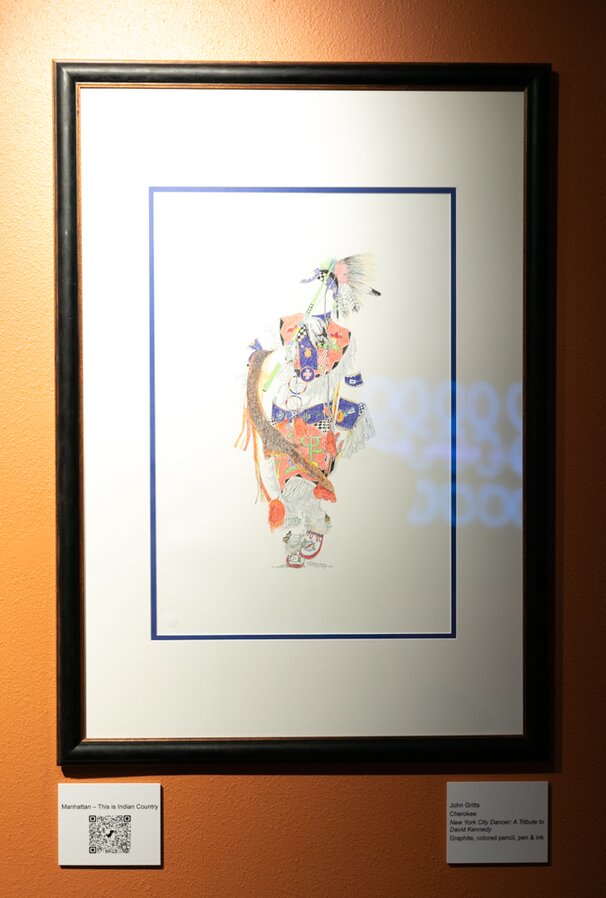
John Gritts, a member of the Cherokee Nation of Oklahoma, is an educator and artist now residing in Golden Colorado. His work has been displayed in art shows in New York City, South Dakota and North Dakota among others. His piece in the "This is Native Art" collection depicts a grass dancer, full of motion, with no hands and no face.
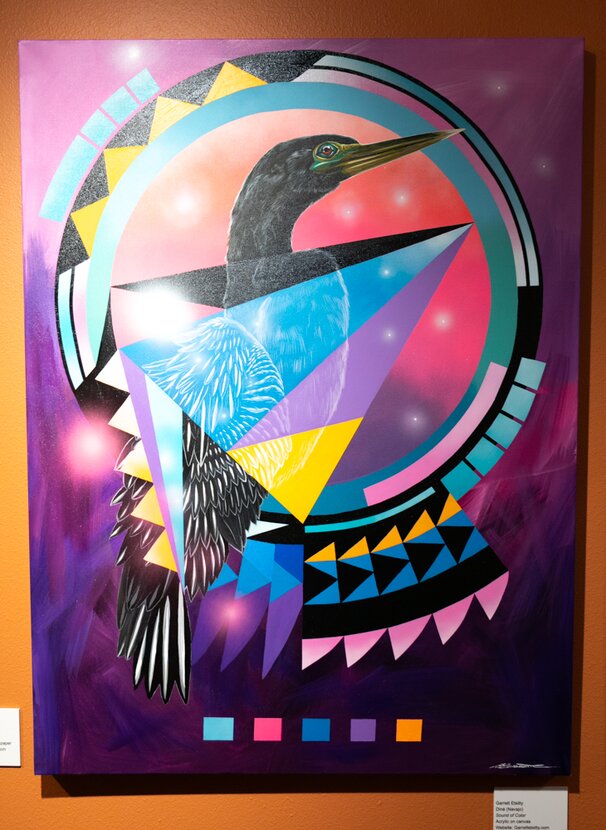
Garrett Etsitty, of the Navajo Nation, is a painter based in Denver who was first inspired by his Grandfather, a Sun Painter, and Grandmother, a Rug Weaver. Throughout his practice, he's continued to draw upon the inspiration of what it means to be a Dine’ person, believing art can be a tool for healing and cultural preservation, specifically among the youth.
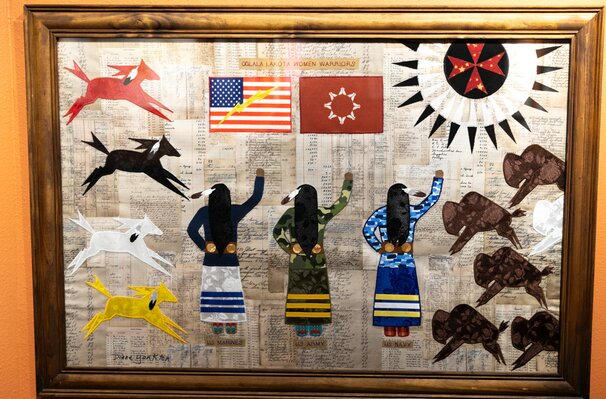
Diane Yankton, part of the Lakota nation, is a Colorado artist who makes regalia and other pieces of clothing for her family and others who have found out about her craft through word of mouth. Her custom ribbon skirts and appliqué shirts are worn by Native folks across the nation. "This is Native Art" holds her very first piece of framed art.
I returned to the Golden History Museum to speak with artist and curator Danielle SeeWalker about the amazing body of work featured in "This is Native Art," as we explore the process and its impact.
ABI: We're here at the Golden History Museum at the exhibition “This is Native Art,” and I'm here with artists and curator, Danielle SeeWalker. Hello, how are you?
DANIELLE: Hi, I'm good, Thank you.
ABI: This exhibition brings together over 35 Native artists, contemporary Native artists from across the US, and you're exploring various aesthetics here. As you can see, there's a lot of variation. Colorado Creative Industries reached out to you to do a show at the state capitol helping to bring these Native artists together. Talk to me about the role of a curator at the opening reception. I learned that uplifting artists is something that you vow to do ever since you were given an opportunity back in 2020.
DANIELLE: Yes. I was really fortunate. Colorado Creative Industries reached out to me last year, late 2024, brought this idea of curating a show at the Capitol building, and my immediate reaction was like, “Absolutely, I want to do that.” And learned through what the curatorial role meant was that I would sort of take the whole show and take control of what kind of art would be brought in, who were the artists.
So, I did an artist call, but I also kind of invited a few artists that I was hoping that could be part of the show that are friends of mine, colleagues in different parts of the US that I'm just personal fans of. But I really wanted the show to be a mix of different types of aesthetics and styles as well as various levels of career artists. So, entry level career artists or artists that are merging or maybe have never shown before in public, mixed in with experienced artists who've been around for a very long time. So, I think it's important to have that balance as well as a balance of lots of different types of media to show really what Native art is today.
ABI: And it's an amazing body of work. I was here on opening night, and the energy was amazing here at the Golden History Museum, and now these pieces have been here for a little bit. And you said that you reached out to some people? Did other people submit?
DANIELLE: Yes.
ABI: Were you going through all these submissions?
DANIELLE: Yeah, so I did do a formal artist call. I put it out and tons and tons of artists from all over the country submitted their artworks, and ultimately, we landed on just over 35 or so artists from around the country representing lots of different tribes and nations that had a great mix of different kinds of vibes, energy and aesthetics.
ABI: Yeah, I was able to speak with a few of the Colorado-based artists, and for instance, this one right here, I think she said it was her first show. So that must've been really cool to uplift not only these seasoned artists that we have in our community and around the world that maybe have more national success, but also the excitement of fresh and new artists.
DANIELLE: Yes, I love Diane's work, and she's such a lovely woman. She's definitely a great part of our Native American community in the Denver area, and she does a lot of sewing, she makes skirts, etc. So I loved how this piece integrated not only the ledger art, which is a historical kind of story about how our art has evolved from painting on raw hides to then being forced onto reservations and not having access to animal hides and then having to create art on these ledger pieces that were given to us by the government. And so, this is sort of her interpretation and integrating her style of putting fabric into her piece. So, she does do a lot of sewing, like I mentioned. And so all of this is made of fabric.
ABI: So cool.
DANIELLE: Yeah.
ABI: I know your piece is here, which we'll get to in a minute as well. Talk to me a little bit about your journey as an artist.
DANIELLE: Yeah. I've been creating art since forever. I get the question a lot, “When did you start creating art?” And it's just sort of something that's been innately embedded into me. I come from a family of self-taught artists. I’m self taught. My sons are super creative. My oldest is also an artist, and so it's just something that has been my medicine, something I've just always relied on and put my energy toward when I couldn't express myself in any other way. So, my art was definitely something very personal, very vulnerable for me. I've only started showing my art publicly since 2020.
ABI: Really?
DANIELLE: Yeah. So, it's still new to me. I guess I'm considered an emerging artist, but in my eyes, I've been creating forever. But yeah, it's been a great journey for me. I am so blessed and so humbled by the opportunities I've been given in just the short time I've been putting myself out there.
ABI: Was there something that just made you say, “Okay, I'm going to take that leap?”
DANIELLE: Yes. In 2020, which was just a weird year for all of us, I think, I was approached by some artists in Denver who were muralists — street artists — and said, “Hey, we're putting together an all women non-binary mural festival. Would you be interested in being part of this inaugural festival?” And I was like, “Well, I've never done a mural before, so I'm not really sure.” And they're like, “That's okay. The whole purpose of this festival is that we’ll pair an emerging, or somebody who has no experience creating murals, with an experienced person. And from there you'll learn and then be able to go.”
So, from there, I was like, why not? It was a year of me trying new things and just being outside of my comfort zone. And so, I did my very first mural, and with that came a lot of other opportunities. People realized that I also did fine art and put paintings and galleries and museums, and started to do that, and it just sort of escalated from there.
ABI: What an awesome way to get out there. Where is your mural located?
DANIELLE: So, that particular mural was in Westminster, Colorado, and it was part of Babe Walls, the festival there, and that was such an amazing experience and really prompted a lot of other great things to happen.
ABI: Well, here you are doing that same thing, uplifting artists with this exhibition, and I'd love to get to the root of this whole collection.
DANIELLE: Sure.
ABI: At the opening reception, you had said, “You know, not every style of Native art is a chief overlooking a mountain, honoring the water.” You wanted to show what contemporary Native art looks like. Can you tell me why that's so important to do something like that?
DANIELLE: So as an artist myself — and you'll see on my piece in a little bit — my art is a little different than maybe what people expect to see in what Native American art historically was or looked like or what people's idea of what it should look like. And so, I get a question a lot from people like, “Hey, do you consider your art Native art?” And I always kind of laugh about that. I'm like, “Well, yeah, I'm Native and I create art, so it's Native art.”
But that really prompted me to do a neon piece that literally says, “This is Native art.” And it's kind of a tongue in cheek nod to that question I get a lot, but what also inspired this show. And so, I wanted to bring together artists that are from all over the country that do all different types of styles and different aesthetics and wanted to really bring together what Native art is today, what it looks like today, and challenge that narrative of what people think it should look like.
ABI: It's so important to do. I know I recently spoke with Julia Keefe, (of) the Indigenous big band, and she said the same thing: “I am Native, therefore it’s Native music.”
DANIELLE: Yes.
ABI: Yeah. Okay. Well, this is an incredible body of work, and I would love to get into a few of these. Can you curate just like a small selection, including one of your own?
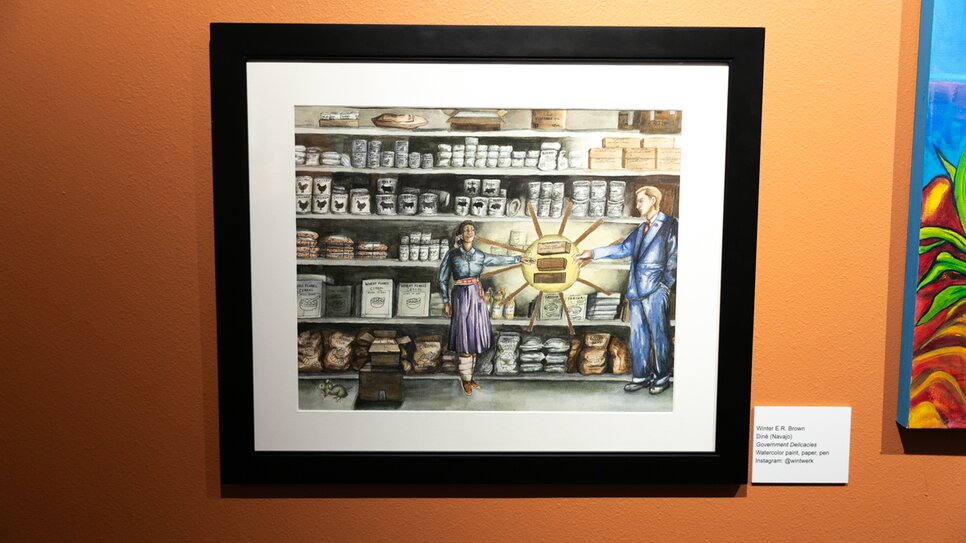
DANIELLE: Sure. Yeah. Let's actually look at this one since we're right here. This one here is one of my personal favorites. I love it. It's by Winter E.R. Brown, who is an emerging artist. I believe they're still a student studying, and this was supposed to be for an art project or an art assignment at school. And when they told me about that and said they thought, “why not? I'll finish it and submit it for this show.” I was like, “Oh my gosh. This was an art project that you almost didn't finish?”
I was really, really excited about it because this particularly tells a story about food commodities, which every Native American today has a story about food commodities. It's food that was given to us when we were forced under reservations. I grew up eating the food commodities, including the ones that are canned and shown in the imagery. So that's why I personally love it. It really just kind of is nostalgic for me, and I just love the story of what it's telling.
ABI: Did you find when you were curating that you were connecting a lot with a lot of shared experiences?
DANIELLE: Yeah, definitely. And I think that's what weaves this whole show together. While every piece looks very different — the styles, the colors, the materials that are being used are all very different, there is this underlying theme and bridge that brings and weaves us all together is the storytelling, our shared experiences. We might be from different reservations, but there's a lot of the same things that we can share in our storytelling.
ABI: I was very curious about the backstory, so thank you for sharing. Let's check out another piece.
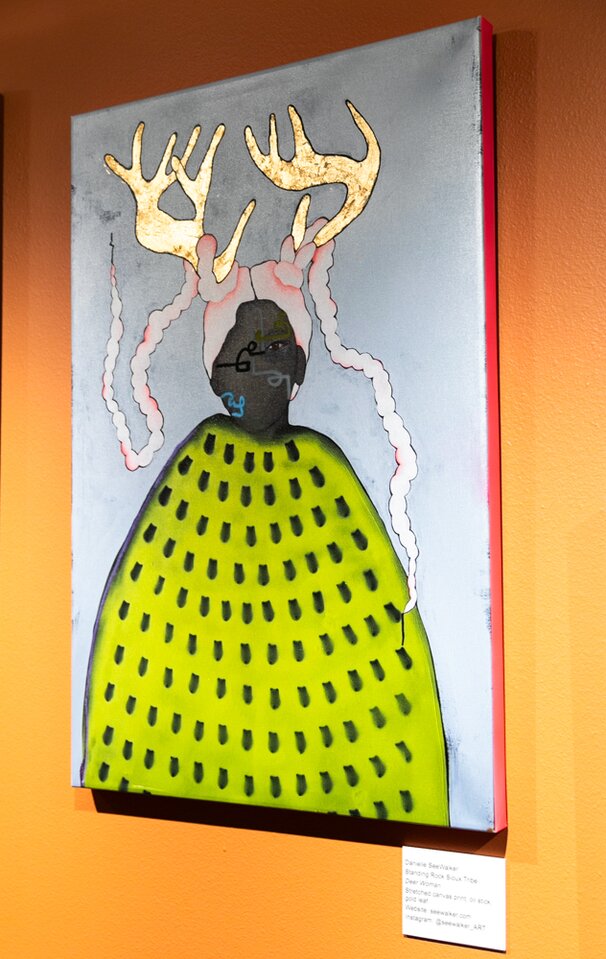

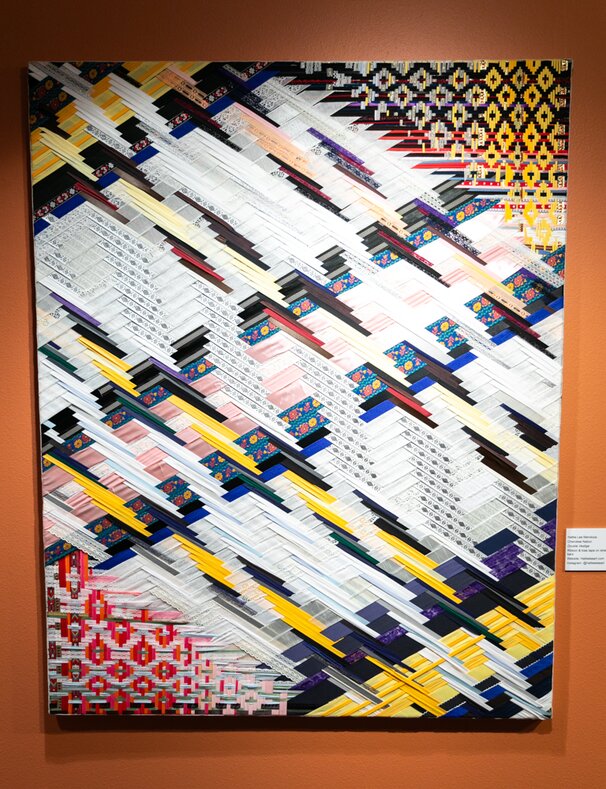
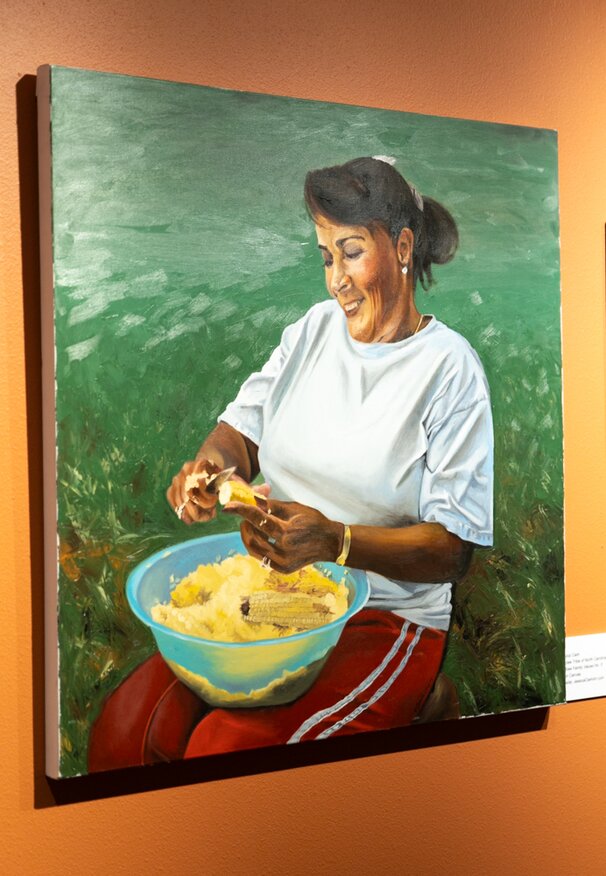
DANIELLE: Okay. We'll go to my piece since I mentioned it. So, this one right here is called “Deer Woman,” and it is from a series of work that I've been working on called “The Braided Women.” So, it's a lot of portraits. They're very similar style in terms of, like, they all have this elk tooth dress they're wearing. The hair sometimes is explained in the piece that has a life of its own. So, this is my interpretation of Deer Woman, who's a figure in a lot of our stories. She is somebody that men should be cautious of and fear, and I really love it in terms of that. It's not only a Lakota figure story, but it's — Deer Woman is also in a lot of other tribal stories as well. So yeah, I wanted to do this piece and bring her alive in what my interpretation of what she looks like.
ABI: I love her. One eye has so much wisdom, and then all of the lines around? Really cool.
DANIELLE: Thank you.
ABI: Yes. Okay. Well, let's check out more. I'm excited.
DANIELLE: Yeah. I think another piece that got a lot of attention, a lot of conversation around it was this one right here.
ABI: Yes.
DANIELLE: I think from across the room when you first enter, your eyes sort of gaze to it because how the movement of what's going on in the piece.
ABI: Absolutely. And the iridescence catching a light.
DANIELLE: Yeah, all the textures, the way the reflections are. And then when you come closer, I think people are realizing like, “Wow, this is fabric. This is ribbon.” And what I really love about this piece by Hattie Lee Mendoza, who's from Cherokee Nation, is, again, this is kind of going back to what I was saying of how everyone's from different tribes. She's from Cherokee Nation, I'm from Standing Rock.
But what brings this together for a lot of us is that a lot of Native women wear ribbon skirts, and it's just a universal kind of piece that we wear during sacred events or during important events, things like that. And so, this piece reminds me of ribbon skirts, and I think a lot of Native people could resonate and come to this piece and be like, “Wow, this is so cool.” But I love that she also wove them together to create patterns and symbols within the piece.
ABI: The fabrics are so beautiful, and the texture is gorgeous. It kind of reminds me of Diane's piece where she brings in her textile work into it.
DANIELLE: Yes, absolutely. So yeah, another kind of favorite piece of me personally, but one that drummed up a lot of conversation.
ABI: Absolutely. Yeah. I really love the one here of the woman. Kind of remind me of my own tías, you know?
DANIELLE: Yeah, I love this piece as well. It's definitely a piece that has storytelling. I can tell that the artist Jessica Clark, who's from Lumbee Tribe in North Carolina, it's called “Family Values Number Five.” She actually did a series of different snapshots of her family, and I could just tell how important family is to her and how traditions of just sitting around and having conversations while you're cutting up vegetables and preparing meals is important. And I can resonate with that as well. I think with a lot of Native people, and a lot of people in general, a lot of cultures and families, when you're sharing together around cooking and eating and meals, it's a really treasured time.
ABI: Well, this whole piece is an insight into the culture, and it's been here for almost a month, and it was at the capitol before. I would love to hear any feedback that you've gotten, like early remarks from people that have come through and seen it all together like this?
DANIELLE: Yes. I actually was chatting with some folks recently who said, “Wow, I saw the show when it was at the Colorado State Capitol, and then I went and saw it at the Golden History Museum, and it was so cool to see all the pieces together in one room.”
At the Capitol, it was such a cool venue to show in that space, but the pieces were kind of spread out. Some were in the rotunda, some were in the lieutenant governor's office, some were in the governor's office, so they were spread out. Accessibility might not have been as easy as coming here because to get access to certain spaces in the capitol, you have to have an appointment. But when you come here and you get to see all the pieces in one room together and sort of salon style, it breathes a different life in I think, different reactions. So, it's been really cool. A lot of great feedback.
ABI: Oh, that's amazing. And it's cool that it's traveling.
DANIELLE: Yes. So, after it leaves Golden, there's plans for it to go to another museum to be announced soon in the state and hopefully keep traveling from there.
ABI: So, this is — and correct me if I'm wrong — the first big curating project that you've done? Or is it not?
DANIELLE: Yeah, this is the first kind of project I've curated in terms of just artwork. I've done other curatorial projects that were — included artwork, but also were around activism, missing and murdered Indigenous relatives where I've done shows to bring awareness to that. And it included artwork but also included other things as well. But I definitely have done several different curatorial projects
ABI: Across the nation as well?
DANIELLE: Yeah.
ABI: Wow. Well, this is just an amazing body of work. Thank you. And I'm so excited to have it travel through Colorado so that it's accessible to so many different people. Any final thoughts for people that are listening and maybe want to come out and check it out?
DANIELLE: Gosh, I don't know. I would say just come out, check it out. Really challenge what your mindset was of what is Native American art. I don't think that you get to see it very often where you get to see a ton of pieces in one space that are from living, breathing, working artists of today. A lot of times we see artwork that is done by people of the past, and they've passed on and now their story lives on through their art. But this is actual working artists that you can come and support, and all these pieces are for sale. So, just a great way to support artists.
Catch “Live & Local” every Tuesday & Thursday on KUVO. Tune in to KUVO JAZZ 89.3 FM in Denver and listen to The Morning Set, weekdays from 7 – 10 a.m. MT. You can also stream online here at kuvo.org or listen to the KUVO App.
Stay connected to KUVO’s programs and our community! Sign up for the Oasis E-News today!


